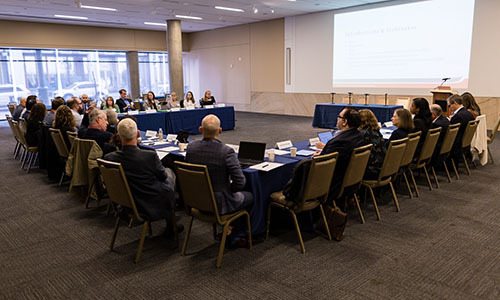Building a Consumer-Centered Legal Market: Takeaways from IAALS’ Convening on Regulatory Reform
 Since 2019, IAALS has been at the forefront of efforts to rethink how we regulate the delivery of legal services and how we can create a consumer-centered regulatory system to ensure a more robust market for high-quality legal services—one that is competitive, broadly accessible, and better meets the needs of the people.
Since 2019, IAALS has been at the forefront of efforts to rethink how we regulate the delivery of legal services and how we can create a consumer-centered regulatory system to ensure a more robust market for high-quality legal services—one that is competitive, broadly accessible, and better meets the needs of the people.
Over the past four years, we’ve witnessed California’s attempt to develop and Utah and Arizona’s respective launches of sandbox and alternative business structure efforts to varying degrees of success. And more recently, additional states around the country have begun to launch programs utilizing other legal professionals and community members to deliver legal help. We believe the regulatory innovation movement is now at a point where we can come together and share lessons learned and recommendations for launching and sustaining regulatory innovation.
To that end, IAALS recently held a convening, “Unlocking Legal Regulation: Lessons Learned and Recommendations for Building and Sustaining Regulatory Reform,” in Denver on October 3–4, 2023. Twenty-three leaders from different regulatory innovation initiatives and IAALS staff participated in two days of thought leadership sessions with the following three objectives as the focus:
- Objective 1: Learn from past and current sandbox and alternative business structure efforts and research, and fold in learnings from the allied legal professional and community-based legal advocate efforts, to develop an initial round of recommendations for launching and sustaining regulatory reform that supplement existing resources.
- Objective 2: Determine what stakeholder groups the regulatory innovation community needs to better engage, how to do so, and what resources still need to be developed to launch new regulatory innovation initiatives and to sustain existing ones.
- Objective 3: Strengthen existing relations—and develop new ones—so the group can continue to work together and build momentum as one regulatory innovation community.
Two initial high-level takeaways from the convening include:
- Every state effort is different for a reason. There are many factors that leaders must consider when determining which model(s) of regulatory reform to pursue and how. Some examples of factors to consider include whether the state is a mandatory or voluntary bar state, whether the supreme court justices in the state are appointed or elected, and whether the model(s) to be pursued is market-based or free to consumers. The answers to these questions will likely dictate which stakeholders will likely be allies, which stakeholders will likely be opposed, and which strategy and approach to pursue.
- We need to better engage the public in regulatory reform efforts. While some organizations and efforts have included public engagement from the outset, (shout-outs to Innovation for Justice and Arizona more generally, as well as Alaska Legal Services Corporation and Frontline Justice), most have not, and this has likely hindered efforts to some degree. The data we have thus far indicates the public is interested in obtaining legal services from alternative service providers such as allied legal professionals and community justice workers, as well as through alternative business models. The more we can engage the public in this conversation, the better chance we have of creating regulatory reform that is aligned with their needs and the better chance leaders have of getting their respective efforts over the finish line.
- Because this is an area within the regulatory reform space that is ripe for further development and impact, IAALS will soon be launching a project on consumer engagement. Stay tuned for more updates!
IAALS will share a more comprehensive list of lessons learned and recommendations for building and sustaining regulatory reform in its post-convening report, currently set to be released in early 2024.



